5 Blog Post Openings That Hook Readers (Based on Science)
Lexi Rodrigo
Next time you want to improve the opening of your blog post, try this:
Click and drag your cursor to highlight the first sentences you’ve written—right until the point you actually get into what the post is about.
And now hit “delete.”
If you’re like most writers, you hem and haw, take a convoluted route, and give all manner of background story before getting to the meat of the post.
Now that you’ve gotten rid of the useless prologue, you can write a proper blog post opening.
How should you write it?
What Really Hooks Readers, According to Research
You want a blog post opening that sets readers on a slippery slope, so when they start reading, they can’t stop.
Up until recently, most bloggers have had to guess at what that slippery slope might look like, but not anymore.
Ben Parr has looked at the research, interviewed psychology and cognition experts, and organized his findings in the book, Captivology: The Science of Capturing People’s Attention.
Parr identified seven triggers that capture people’s attention:
- Automaticity Trigger
Some sensory cues like colors, symbols, and sounds automatically catch our attention.
- Framing Trigger
Adapting to or changing somebody’s view of the world makes people pay more attention to you.
- Disruption Trigger
Going against what people expect makes them pay attention.
- Reward Trigger
When you leverage people’s motivations for intrinsic and extrinsic rewards, you get their attention.
- Reputation Trigger
Reputable experts, authorities, and even the crowd can instill trust and captivate audiences.
- Mystery Trigger
Mystery, uncertainty, and suspense keep audiences attentive until the very end.
- Acknowledgment Trigger
People tend to pay attention to those who provide them with validation and understanding.
Below are five kinds of blog post openings that get attention by using these triggers.
1. Empathetic Opening
SmartBlogger’s Jon Morrow made this type of blog post introduction popular, back when he was still editor of Copyblogger. Hence, it has been called “The Morrow Opening.” It’s similar to what copywriter Clayton Makepeace calls the Dominant Emotion Lead in sales letters.
It’s so reliably successful that you’ll find this style in many blog posts today. Jon says blog posts with this type of opening tend to get more traffic, more comments, and more social shares. What’s not to like, right?
The Empathetic Opening is powerful, because it shows how well you understand your reader and makes an instant connection with them. They read your introduction and think, “This writer knows exactly what I’m going through. Therefore I trust that she must have the solution to my predicament as well.”
That’s right, the Empathetic Opening gets attention by using the Acknowledgement Trigger.
Here’s an example of an Empathetic Opening, straight from Jon’s blog:
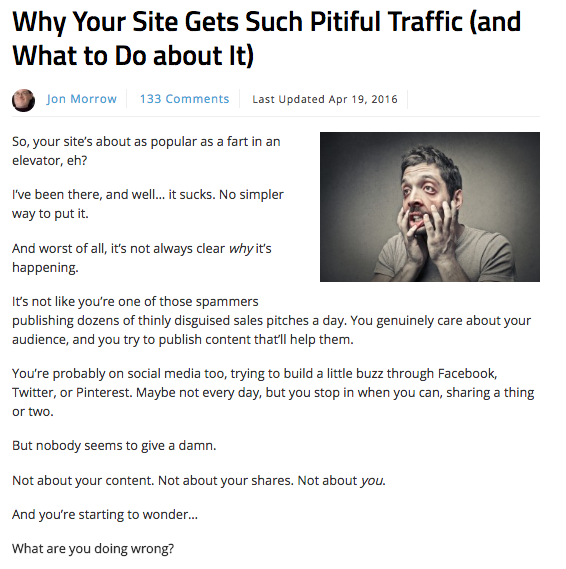
How to Write an Empathetic Opening
- Put yourself in your reader’s shoes and write down everything you think they’re experiencing. What are they thinking? What do they hear from others? What do they see, hear, touch, taste, or smell in their environment? What are their dreams? What problems and obstacles are in their way? And, most importantly, how are they feeling?
- Choose which of the things you wrote will resonate most strongly with your reader. Paint a picture of your reader’s current situation.
- Write your introduction and segue to the solution you offer.
2. Shock and Awe Opening
Another effective way to open your blog post is by using shock and awe. You can do this by stating an odd fact, shocking statistic, surprising prediction, or polarizing statement. It uses two attention-getting triggers:
- Framing Trigger (presenting something to think about and a certain way of thinking about it)
- Disruption Trigger (disrupt the reader’s normalcy with something unexpected)
The Shock and Awe Opening gets attention, because humans love intrigue and fascination. According to Neuro-linguistic Programming, this type of introduction creates a pattern interrupt—a disruption of a routine or a pattern.
This causes people to stop and think. You’ve aroused their curiosity, and now, they want to know more. The success of this type of opening is also related to people’s FOMO (fear of missing out).
This post you’re reading, for example, uses a Shock and Awe Opening, where I tell you to delete the entire introduction of your draft blog post.
Another example is from Mirasee CEO, Danny Iny, where he takes an opposing stance to Seth Godin, bestselling author, popular speaker, and marketing authority:
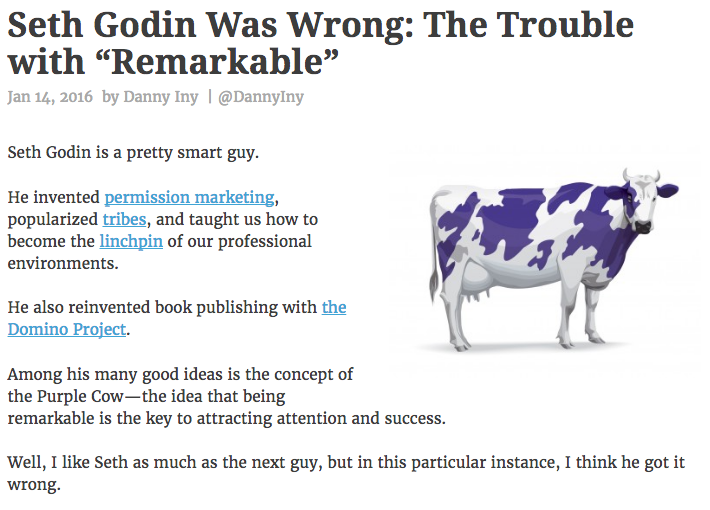
And here’s another example, in which I make a bold and unusual claim. What does choosing an online learning platform have to do with dating, love, and divorce anyway? I tie them all together in this post:
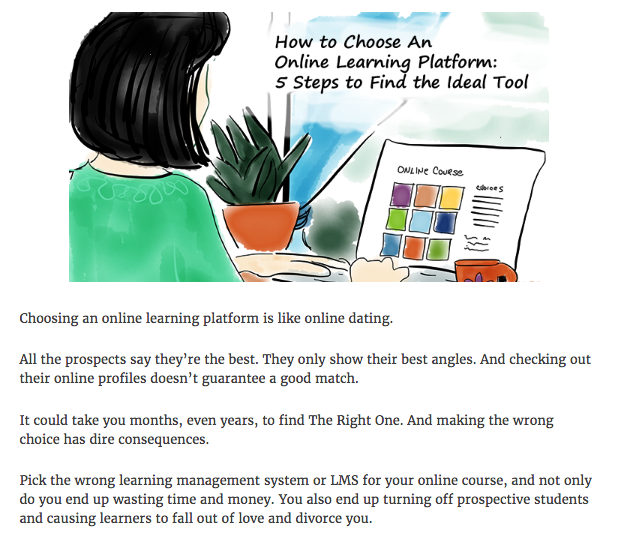
How to Write a Shock and Awe Opening
- Conduct a thorough research of your topic. Look for statistics, research studies, and other information. You never know when something that looks trivial would make for an attention-grabbing introduction.
- Sometimes the topic of your blog post lends itself to a Shock and Awe Opening. These include posts that contradict popular opinion, show an unusual way of doing something, or reveal little-known hacks.
- If you are beginning your blog post with statistics, weave them into your writing in an engaging manner, rather than spouting off dry numbers.
3. Question Opening
Ever notice how a lot of blog posts begin by asking a question or a series of questions?
See what I did there? 😉
Starting your blog with a question is like approaching a stranger and saying, “Hi, how are you?” They simply must pay attention to you and give a response.
Depending on the kind of question you ask, this opening can use the:
- Automaticity Trigger (when we hear a question, we’re inclined to answer)
- Framing Trigger (your question makes them think of a topic and in a certain way)
- Disruption Trigger (shocking fact embedded in a sentence)
- Acknowledgement Trigger (the answer to your question reinforces their current thinking or experience)
Questions also “jump-start the mental conversation with your prospect,” Michael Masterson and John Forde say in Great Leads: The Six Easiest Ways to Start Any Sales Message. “Once well-targeted customers answer ‘Yes’ to what you’re asking, it’s that much tougher for them to quit reading.”
Here’s an example of a post with a Question Opening that uses the Acknowledgement Trigger:
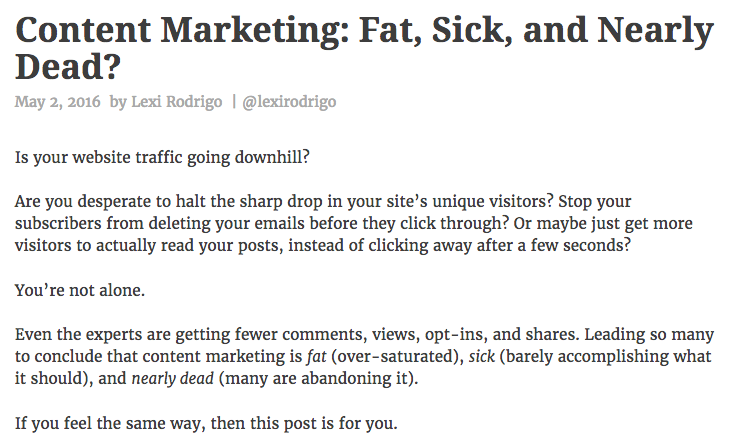
How to Write a Question Opening
- Think of questions that your readers are likely to answer “yes” to. One way to do this is by, again, listing all the things your reader is thinking, feeling, and experiencing. If you don’t truly know your readers, then you’re bound to ask a question that will flop:
You: Have you ever dreamed of having a date in a hot-air balloon?
Reader: Um, no.
- Another type of question is one that piques your reader’s interest. You can use a shocking fact with your question: “Did you know that…?” “Have you heard….?”
- Be as specific as possible. Specificity engages your reader’s imagination. In the example above, instead of asking, “Are you unhappy with your site traffic and engagement?” I wrote, “Are you desperate to halt the sharp drop in your site’s unique visitors? Stop your subscribers from deleting your emails before they click through? Or maybe just get more visitors to actually read your posts, instead of clicking away after a few seconds?”
4. Story Opening
The popularity of Netflix is yet another proof that people love stories!
A Story Opening works, because readers get emotionally involved. They want to know how the story ends, and so they keep reading until it’s too late. They’re hooked.
Stories can provide all sorts of attention triggers, including:
- Reputation Trigger (stories about famous people)
- Reward Trigger (someone achieved success and you can, too)
- Mystery Trigger (how will it end?)
Self-development blogger James Clear is particularly fond of (and good at) opening his posts with stories that have the Reputation and Mystery Triggers, such as this:
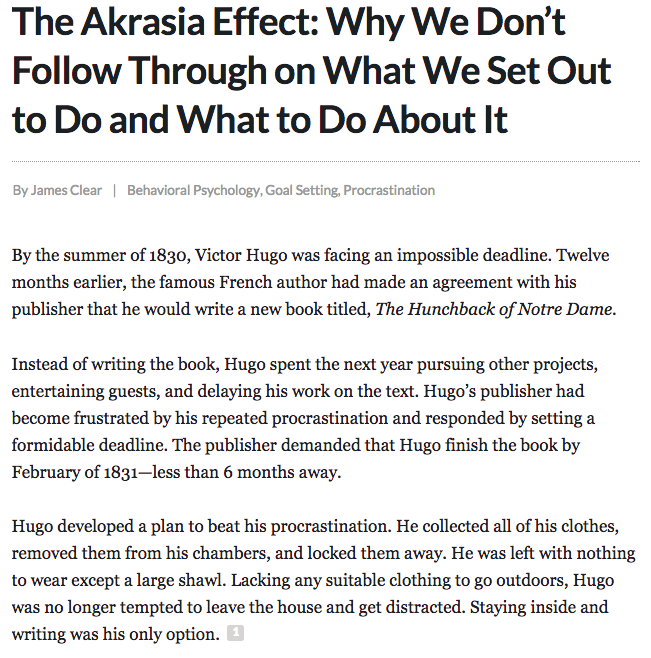
Stories are particularly useful for humanizing an otherwise intellectual topic, such as in this post by Danny Iny for business website Inc.com:
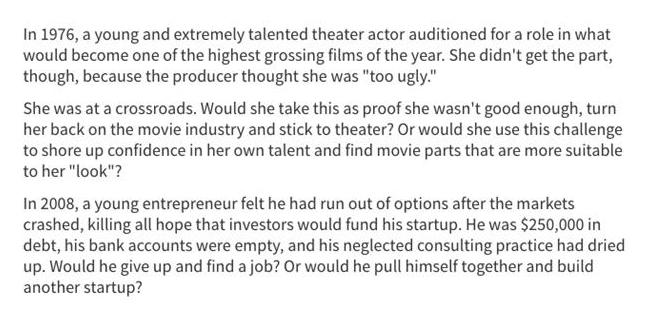
How to Write a Story Opening
- Find a good story to tell. When doing research for your post, keep your eye open for relevant stories. Mine your own experiences for stories that can illustrate a part of your post. Or ask friends and family if they have relevant experiences.
- Better yet, keep a story bank: as you come across stories, bookmark or collect them into a document. That way, you have stories even before you need them.
- Your Story Opening should be concise. You can tell a story in one sentence, if you must. Don’t go on and on about it.
- Make sure the story you’re telling is relevant to the post. Don’t use a story simply for the sake of telling a story. Tie it back to the post topic.
- To make your Story Opening even more enticing, put the Mystery Trigger in action: don’t tell the ending until the end of your post.
5. Quote Opening
I love quotes.
And judging from the popularity of quote memes, quote-dedicated websites, and entire books of quotes, I’m not the only one.
If you’re pulling your hair thinking of how to begin your post, a pithy quote that gets to the heart of the matter is the easiest solution.
Quotes can carry the:
- Reputation Trigger (if the quote is from a famous person)
- Framing Trigger (the quote makes the reader ponder)
- Disruption Trigger (preposterous quote goes against conventional wisdom)
Maria Popova of the blog, BrainPickings, writes a lot about books she’s read. Naturally, her posts contain a lot of quotes. She begins her posts with a relevant, thought-provoking quote:
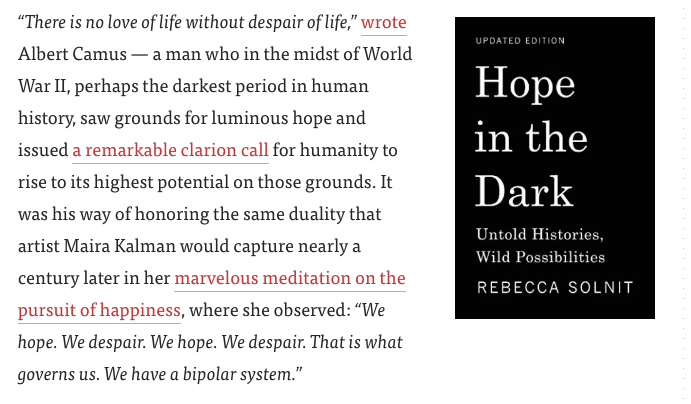
And if you use a little-known or unexpected quote, the better, like when Danny quoted Dr. Seuss:

How to Write a Quote Opening
- When doing research for your post, look for related quotes.
- Choose a quote that’s not yet tired (if it has a meme, it’s probably over-used). Choose something fresh and thought-provoking.
- If the connection isn’t obvious, tie the quote to the rest of your blog post.
- Always give proper attribution to the source of the quote, with a link, where possible.
When Should You Write The Blog Post Opening?
Since a lot rests on the quality of the blog post opening, and it’s not that simple to write, you probably won’t write a great one right off the bat.
In fact, expect that the first drafts of your blog post will have a no-good, so-so opening. Assume that you will have to work and rework it and polish it to eye-catching perfection.
Confession: When I’m drafting a blog post, 90 percent of the time I don’t know how to begin it. Just to get through the draft, I type, “blah, blah, blah” and write the rest of the post
And then I wait.
Sometimes, my subconscious reveals a good opening to my conscious mind while I’m out walking, or early in the morning when I’m half-asleep, half-awake. Other times, I unearth a good introduction as I do research. Still other times, it’s a struggle, plain and simple, and I just have to pick one type of opening and make the best of it.
It’s Work. Deal With It.
The point is, coming up with a halfway decent blog post opening is hard work. Don’t baby the process. Don’t rush it.
“The most important sentence in any article is the first one,” wrote William Zinsser in On Writing Well.
The book was first published in 1976. Yet that statement remains true today, and especially so for bloggers, whose readers have a shorter attention span than goldfish.
You simply can’t afford to publish posts with lame openings.
Tell me. How have you been writing the openings of your blog posts? Which type of introductions will you be trying with your next post? And what types of openings appeal to you when you read blogs?
Write Blog Post Openings That Captivate Readers!
Get the cheat sheet to write 5 blog post introductions that set off attention triggers, according to captivology research.
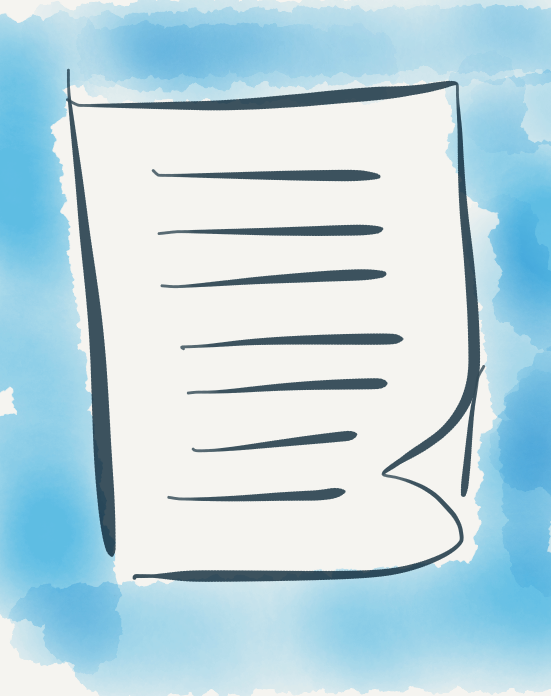
Shafeek
Excellent post, Lexi. I have been using the question opening in my blog posts. This gives me a lot of options. Thank you.
Lexi
@Shafeek – The question opening works great! But you’re right, sometimes it’s good to mix things up. I hope the other formats are working well for you 🙂
Kato
Thanks for the education. My blog posts will surely be more captivating now.
Personally, I think I will vary the types of openings for the sake of flavour.
Thanks again Lexi
Lexi
@Kato – You’re very welcome! I had a lot of fun researching for this post. And, yes, variety adds spice to your writing 😉
Joelle
Lexi I loved that thank you so much! It was so helpful and I feel really clever knowing the “proper” terms for the psychology behind it! Thank you x
Lexi Rodrigo
Hi Joelle, thanks for stopping by and for letting me know you found the post useful. Let me know when you use one of these openings for a blog post. I’d love to read it 😀
Fixmansion
Wow!! This was such a great article, I grabbed some points from it. I usually use questions and suspense to start my posts.
Lexi
@Fixmansion – Awww, thank you for that great feedback! I’d love to learn more about how you use suspense in your blog post openings.
Ellen
Really enjoyed this, especially with the examples. But I’m still not clear on what the Framing Trigger does. Could you give an example to help me grasp it? Thanks! I’m sharing this with my MM group!
Lexi Rodrigo
@Ellen – Excellent question! The Framing Trigger is all about how your present your message so that it aligns with your audience’s thinking about it. Think of how you choose a frame for a painting or picture to emphasize its best qualities or make it stand out on a wall of other pictures. You can accomplish this either through complementarity (your reader thinks, “This author gets me. I’m going to read more.”) or contrast (“That’s out of this world. Say that again?”). It is the trickiest trigger to use, especially when you’re trying to change how people see things, because we tend to hold on to our thoughts and opinions. Hope that helps!
Antoniya
An outstanding blog post, Lexi, pinning for later usage with every blog post I write, thank you!
Lexi Rodrigo
Happy to hear it, Antoniya! Let me now if you have any questions 🙂
Alan Lam
Hey Lexi,
What a fantastic article.
The funny thing is, I’ve recently encountered the problem of creating thought provoking openings in my own articles, so these techniques have come at the perfect time!
Lexi Rodrigo
Alan, you’re the second person to tell me this post came at the perfect time. It’s wonderful to know you’ve been able to put it to use right away. Which type of opening did you choose for the post you’re working on?
Kim Orr
Lexi,
This is a wonderful summary of various kinds of openings. It helps to have the great examples you provide. This is a keep-and-refer-back-to post!
Lexi Rodrigo
Thanks, Kim! I love the term you used to describe it: “keep-and-refer-back-to post”. I’m taking a screenshot of your comment 🙂
E.S. Dewhurst
What a great post, Lexi! I’m bookmarking this article. It’s a useful resource for any content marketer’s toolbox!
Lexi Rodrigo
Thank you for the kind words, E.S.! I’m so pleased that you found it useful enough to bookmark. Which blog post opening will you be trying next?
Calvin Black
Great summary Lexi! Thanks for the breakdown of these techniques. I look forward to using the download guide as a resource this year.
Lexi Rodrigo
Awesome to hear that, Calvin! I hope you find the guide useful! Let me know if you have any questions.
Mandy Allen
I do often use a question, yes, and I often tell a story. I love all these triggers and can certainly manipulate my writing to incorporate these techniques. Thanks for sharing!
Enjoy the journey!
Lexi Rodrigo
Glad you found some familiar openings in this post, Mandy! Are you going to try some new ones?